As Easter approaches, I’m thinking about all the goodies that will be filling up my grocery cart pretty soon:

Eggs to hard boil, sprinkles and sugar for colorful cookies, bright food dye, a hefty ham, and the ingredients I’ll need to whip up a batch of sweet and fluffy hot cross buns!
Marked with a cross, these spiced bread rolls are a fixture on many Easter tables, along with beautiful seasonal decorations and tableware.
While the cross now symbolizes the crucifix, there are many superstitions and legends that precede the popularized Christian meaning.
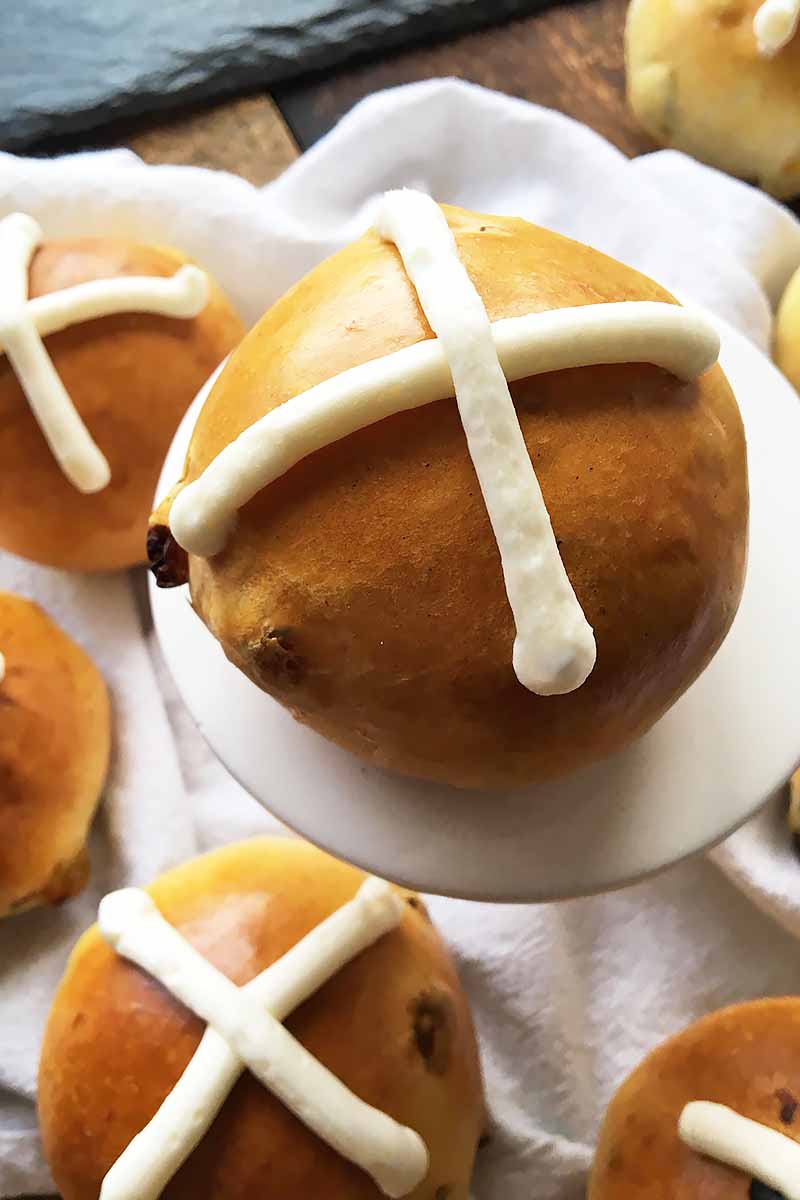
Though its exact origins are still unknown, there are numerous pagan references that the cross represents not a crucifix, but the astronomical moon and its four quarters.
Supposedly, with the Romans’ arrival in Britain, the clergy believed this bread threatened the church. However, because hot cross buns were so popular amongst the public, a complete abolishment of the recipe was futile.
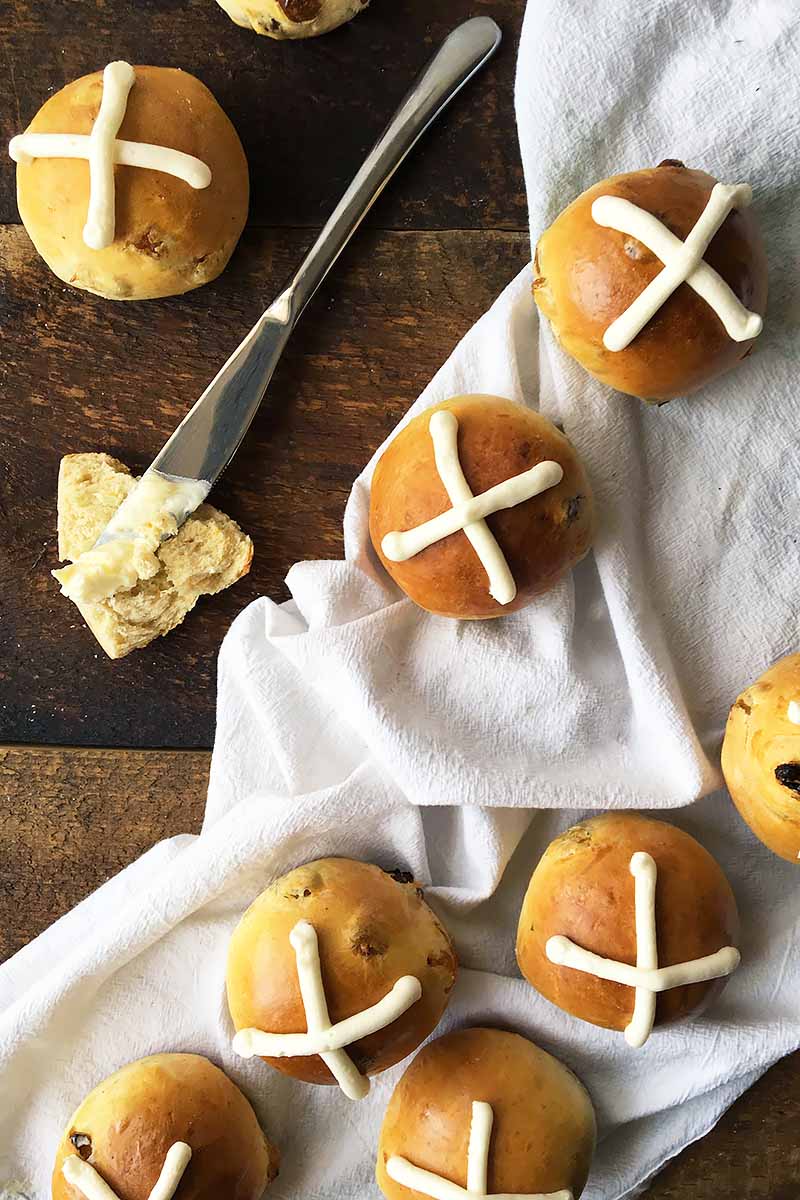
Instead, the clergy blessed the buns, and switched the meaning of the cross from the moon to the crucifix.
English folklore said the hot cross buns baked on Good Friday would not grow mold or spoil throughout the coming year. Some believed that these buns held medicinal properties.
Others thought that if you hung one in the kitchen, fires would be prevented and all breads would turn out perfectly. Sailors would bring these buns along with them to ensure a safe voyage.
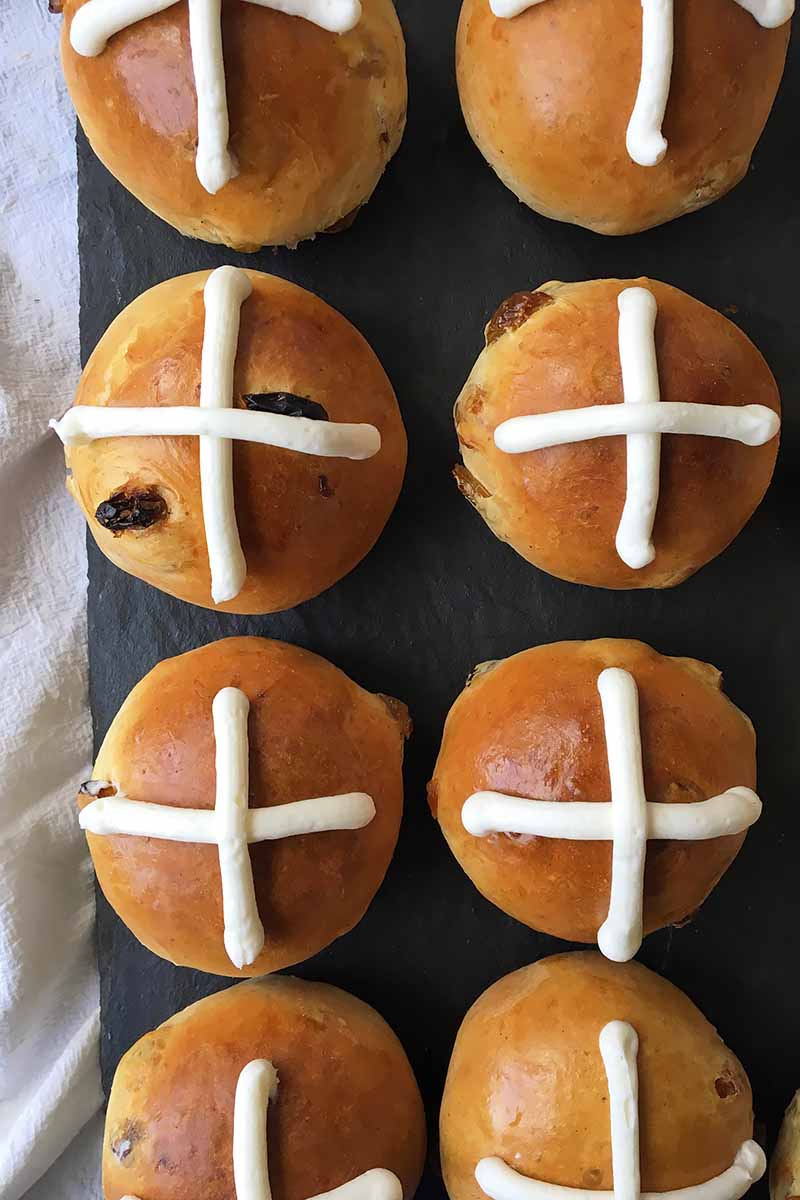
The sweetest of all folklore was that hot cross buns exchanged between friends would guarantee a lasting friendship.
Baking this recipe is a great tradition to start this Easter season – make a batch this year!
Print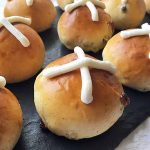
Hot Cross Buns
- Total Time: 4 hours, 25 minutes
- Yield: 15 buns 1x
Description
A traditional British Isles bread popular during Easter, sweet and fluffy hot cross buns are thought to be a sign of lasting friendship.
Ingredients
For the Dough:
- 1 cup whole milk, divided
- 1/2 cup plus 1 teaspoon granulated sugar, divided
- 1 package (1/4 ounce) active dry yeast
- 4 cups all-purpose flour
- 1 teaspoon salt
- 1/2 teaspoon ground cinnamon
- 1/2 teaspoon ground nutmeg
- 1/4 teaspoon ground ginger
- 1/4 teaspoon ground allspice
- 1/2 stick (2 ounces) unsalted butter, softened
- 2 teaspoons vanilla extract
- 2 large eggs
- 1/2 cup dried currants
- 1/2 cup raisins
- 1 teaspoon freshly grated lemon zest
- 1 teaspoon freshly grated orange zest
For the Egg Wash:
- 1 large egg
- 1 tablespoon whole milk
For the Icing:
- 2 cups vanilla buttercream frosting
Instructions
- In a medium bowl, combine 1/4 cup milk and 1 teaspoon sugar. Stir in the yeast and set aside until foamy, about 10 minutes.
- In the bowl of a stand mixer, whisk together on low speed the flour, salt, spices, and remaining 1/2 cup sugar. Switch to the dough hook and mix in the yeast mixture, softened butter, eggs, vanilla, and remaining 3/4 cup milk at medium-high speed. Mix in the currants, raisins, lemon zest, and orange zest.
- Knead the dough until soft and elastic, but still a little sticky, about 5-8 minutes.
- Form the dough into a ball and place in a large bowl greased with a thin layer of vegetable oil. Roll the ball entirely in the oil. Cover the top of the bowl with plastic wrap, and rest the dough at room temperature for 2 hours, or until it has doubled in size.
- Punch down the dough. Turn the dough out of the bowl and pat into a large rectangle. Divide the dough into 3 roughly even ropes. Divide each rope into 5 pieces, yielding 15 pieces total. If using a scale, each piece should weigh about 3 ounces.
- Roll each dough piece into a smooth ball shape. Place each ball, seam side down, on a sheet pan lined with parchment paper or a silicone mat. Leave about 1/2 inch of space between each one, arranged 5 across and 3 down.
- Place a towel over the dough. Let it sit at room temperature until the balls double in size, about 1 hour.
- While the dough is rising, preheat the oven to 375°F.
- Prepare egg wash by beating 1 egg and 1 tablespoon milk in a small bowl. Using a pastry brush, brush each bun with egg wash.
- Bake 20-25 minutes, or until the buns are browned and shiny on top.
- Remove from oven and let cool for 10 minutes before transferring to a wire rack to cool completely.
- Place the buttercream frosting in a piping bag fitted with a small round tip. Pipe two lines of frosting across each bun to create a cross. Serve!
Notes
Foodal recommends using half of a batch of this rich and fluffy American-style Buttercream for the decorations.
- Prep Time: 1 hour
- Cook Time: 25 minutes
- Category: Bread
- Method: Baking
- Cuisine: Baked Goods
Keywords: hot cross buns, Easter, bread
Cooking by the Numbers…
Step 1 – Make the Dough
In a medium bowl, combine 1/4 cup whole milk and 1 teaspoon of granulated sugar. Mix in the yeast and let sit until foamy, about 10 minutes. This helps to jump-start the rising of your bread, to make it soft and fluffy.
In a bowl of a stand mixer, whisk together the all-purpose flour, salt, spices, and remaining 1/2 cup sugar.
We love the mix of warming spices like cinnamon, nutmeg, ginger, and allspice found in this recipe! You might need to find some extra storage for all of these, if you don’t have them on hand already – check out our review of the best spice racks.

Fit the bowl to the stand mixer, with the dough hook attachment. On medium-high speed, mix in the yeast mixture, softened unsalted butter, eggs, vanilla extract, and remaining 3/4 cup milk. Add the dried currants, raisins, and the lemon and orange zest.
If you don’t already have a zester or a microplane, then read our article on the top models to help you choose one.
Knead the dough on medium-high speed until soft and elastic, but still a little sticky. This will take about 5-8 minutes.
Step 2 – First Rise
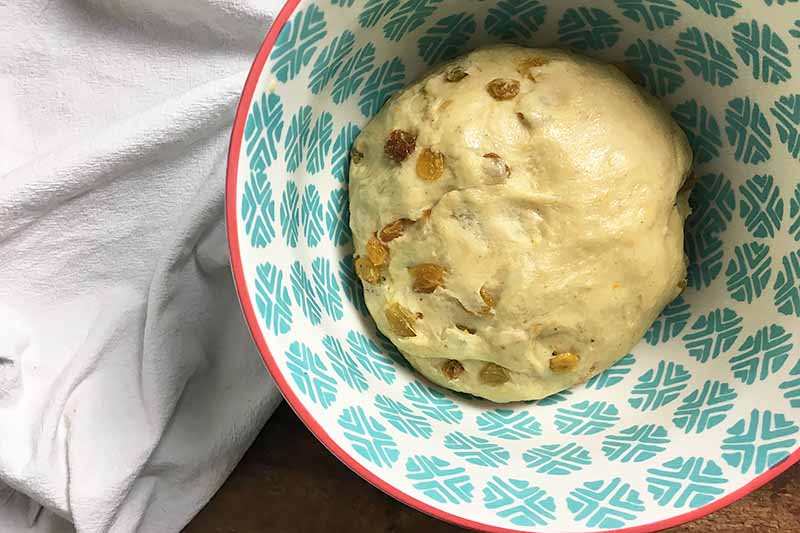
Form the dough into a ball and place it in a large bowl greased with a thin layer of a neutral-flavored vegetable oil. Roll the ball entirely in the oil.
Cover the top of the bowl with plastic wrap, and rest the dough at room temperature for 2 hours, or until it has doubled in size.
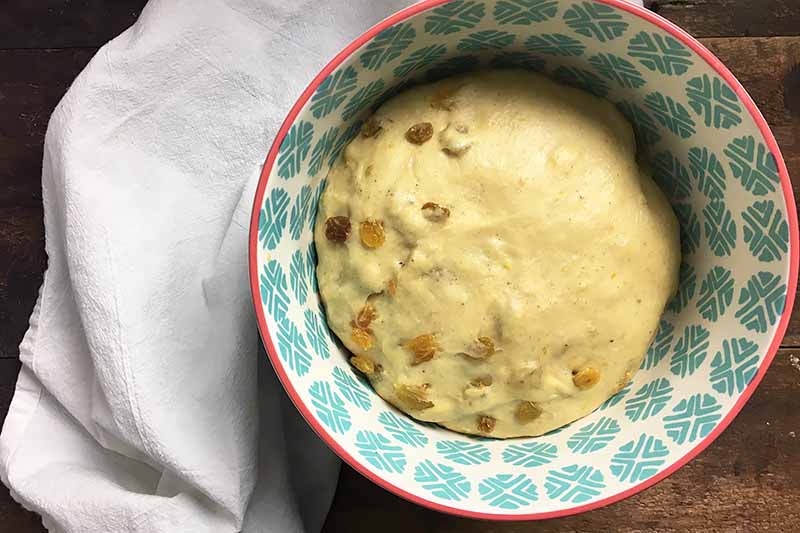
If you have a warm spot in your home, definitely put it there to speed the rising process.
Step 3 – Shape
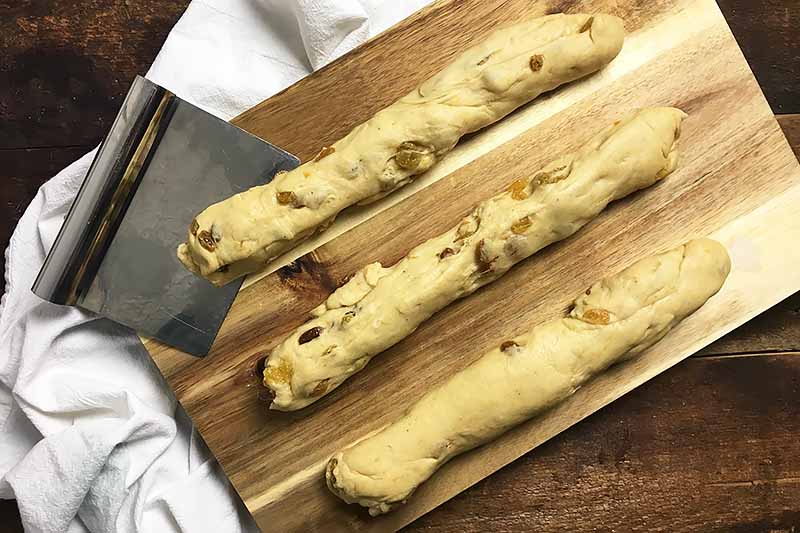
Punch down the dough. Turn the dough out of the bowl and pat it into a rectangle on a clean, flat work surface.
Using a bench scraper or sharp knife, divide the dough into 3 roughly even ropes. Divide each rope into 5 pieces, yielding 15 pieces in total.

I suggest using a kitchen scale for an accurate measurement to get even rolls. Each piece should equal about 3 ounces.
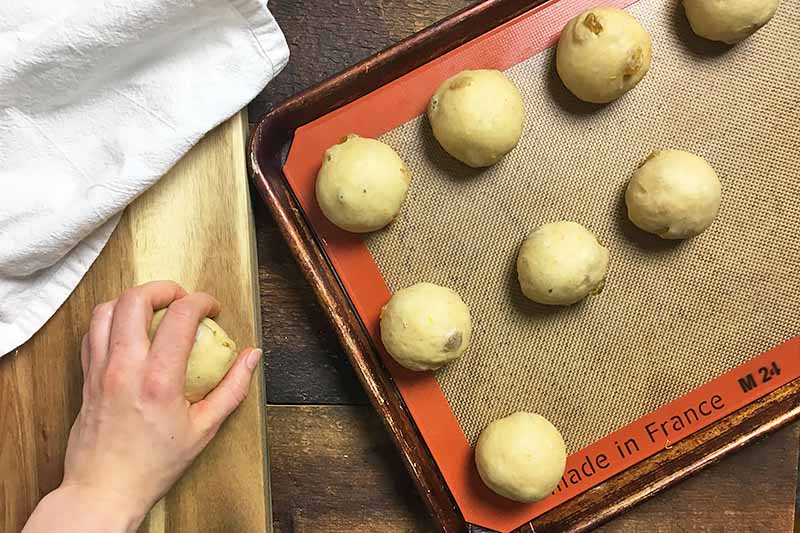
Using your hands, roll each dough piece into a smooth ball shape. Place each ball, seam side down, on a sheet pan lined with parchment paper or a silicone mat. Leave about 1/2 inch of space between each one. Place them in rows with 5 across, and 3 down.
Step 4 – Second Rise
Place a clean kitchen towel over the dough. Let the dough sit at room temperature until the balls double in size, for about another hour.
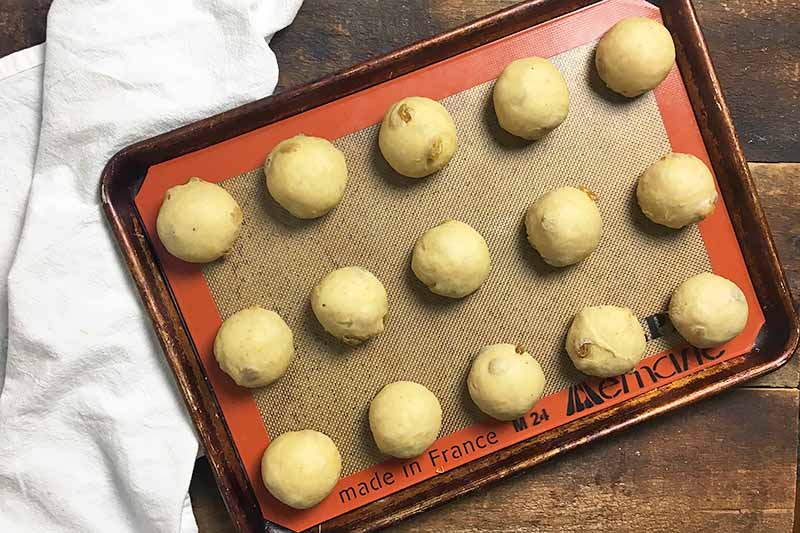
During this step, preheat your oven to 375°F.
Step 5 – Egg Wash
Combine one egg and a tablespoon of milk in a small bowl, and whisk them together. Using a pastry brush, gently brush the top of each roll with the egg wash.
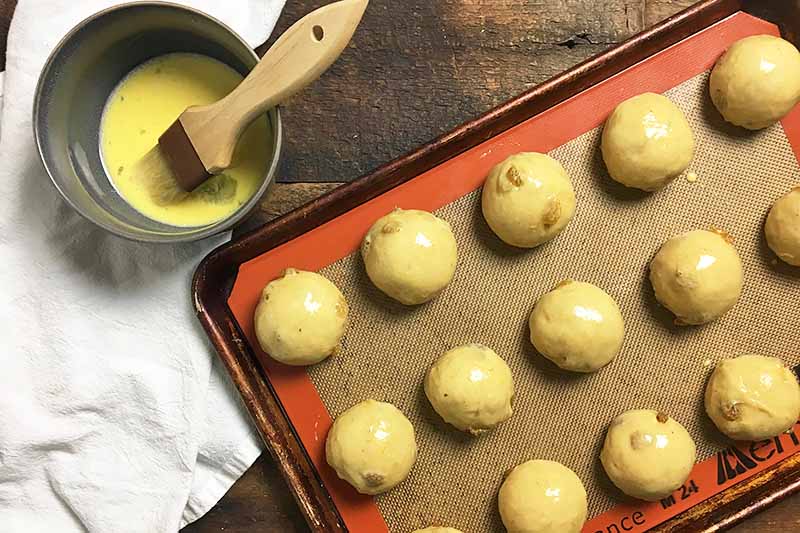
This will give the buns a beautiful, shiny appearance when they are baked.
Step 6 – Bake

Bake for 20-25 minutes, or until the buns are browned and shiny on top.
Remove the pan from the oven and let cool for 10 minutes before transferring the buns to a wire rack to cool completely.
Step 7 – Decorate
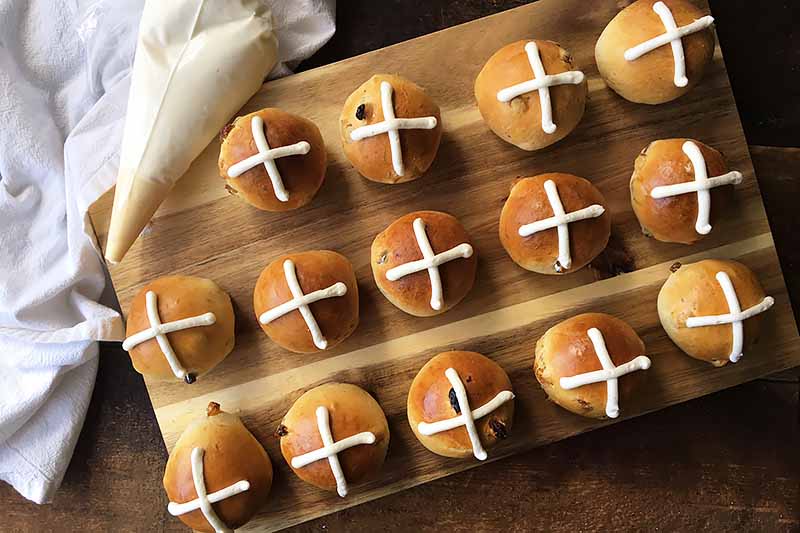
Use your favorite vanilla frosting to pipe crosses on the top of each cooled bun. I prefer to use a stiffer icing that will hold its shape, like Foodal’s American-style buttercream or Swiss meringue buttercream.
Serve and enjoy!
A Legendary Easter Treat
I hope you enjoy all of the fun origin stories and legends behind this recipe, just as much as you enjoy eating a freshly baked batch of hot cross buns with your family this Easter!
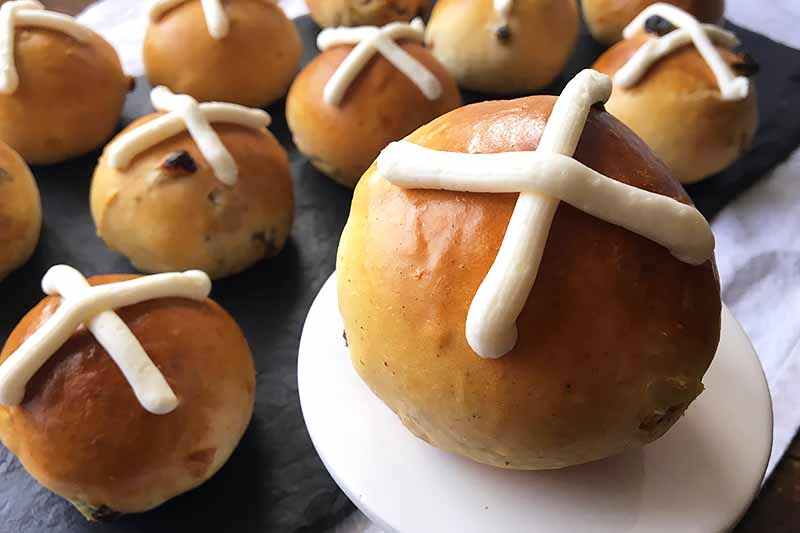
Have you heard of any of these legends before? Do you have any new tales to share that pair with this recipe? Entertain us all by leaving a comment below, after you rate the recipe.
If you had fun making these, check out our entire collection of breads that you can bake all year long.
For more Easter sweet treats, we have a delicious list for you to try:
Photos by Nikki Cervone, © Ask the Experts, LLC. ALL RIGHTS RESERVED. See our TOS for more details. Originally published on March 27, 2015 by Jennifer Swartvagher. Last updated: November 11, 2020 at 13:39 pm.
Nutritional information derived from a database of known generic and branded foods and ingredients and was not compiled by a registered dietitian or submitted for lab testing. It should be viewed as an approximation.
About Nikki Cervone
Nikki Cervone is an ACS Certified Cheese Professional and cheesemonger living in Pittsburgh. Nikki holds an AAS in baking/pastry from Westmoreland County Community College, a BA in Communications from Duquesne University, and an MLA in Gastronomy from Boston University. When she's not nibbling on her favorite cheeses or testing a batch of cupcakes, Nikki enjoys a healthy dose of yoga, wine, hiking, singing in the shower, and chocolate. Lots of chocolate.



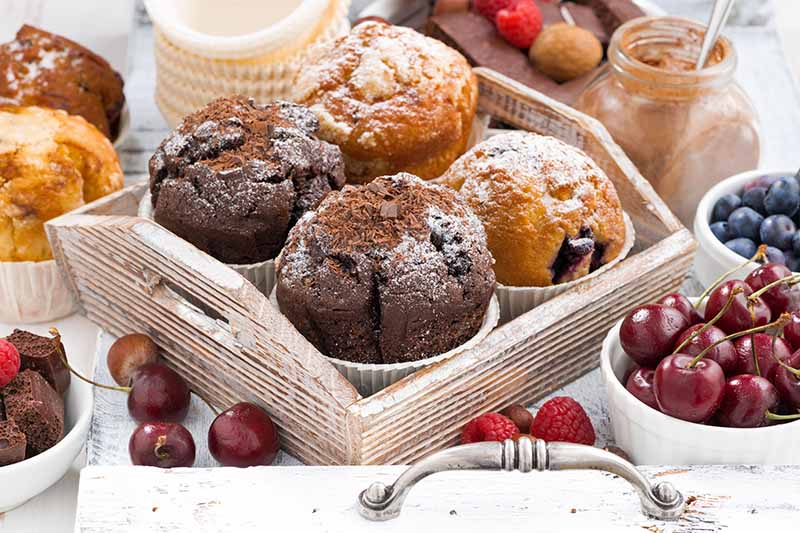
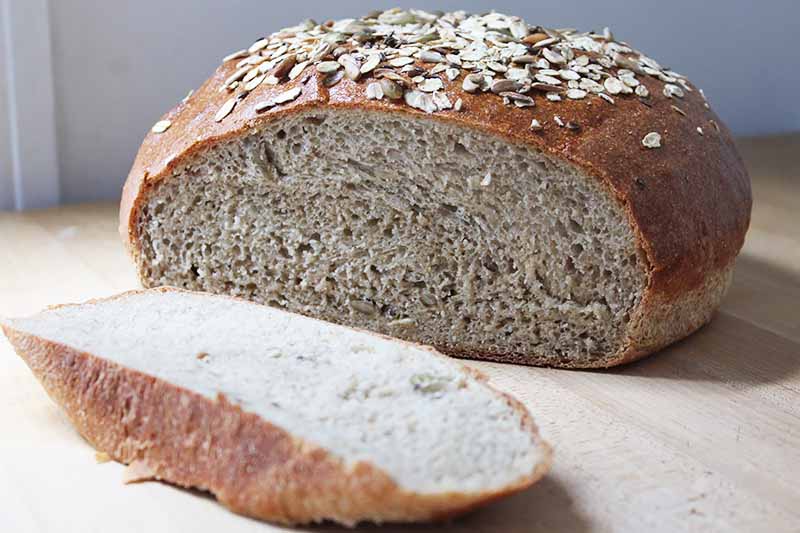
It’s great to have a recipe for these buns – it means I’ll be able to omit the peel. Whilst hot cross buns can be delicious, especially when they are toasted and buttered, it’s rare to find any for sale which don’t contain the peel. So I think I’ll be giving this recipe a try on Good Friday. Thanks!
Ah yes, this classic Easter treat. I always love eating ’em even when it’s not Easter. Great with a glass of milk, or sometimes I’d spread some butter on them as well.
I have a question I’m wondering if anyone knows the answer to: Did ‘crossing’ bread (or scoring in a cross pattern) originate in Ireland? I know it’s a tad left field but I always wondered about this. I know they had a saying something akin to ‘the cross allows the demons to escape the bread’.
I have heard that superstition about bread in general. I am not sure it is associated with Hot Cross Buns.
Hot Cross Buns are great comfort food. I love smelling them when I walk through the in-store bakeries. Baking them yourself is so much better, because you can omit some of the zest which I’m not so fond of. I prefer them toasted or warmed as they taste so much better.
I like to add extra cinnamon to my hot cross buns – they just taste that little bit better. Not too much mind, just that extra dash here and there. Then, when they’ve cooled, toast them and spread button on them so it melts. Mmmm.
Ummm, these look tastes. I think I’m more interested in the history than anything. I doubt I’ll hang one in my kitchen, lol, but giving one to a friend will definitely be something I can handle 🙂
Those are delicious and look very tasty! It’s actually one of my most preffered things to eat while it’s Easter time. They taste so good with chocolate milk and even with just milk. I’ll definitely make some this year!
I love holiday recipes, they bring attention to the food and culture, and remind us of past times. I can recall having these as a child, but they’re not prevalent where I live now, so I’m glad I found this recipe, and can make my own. Although there are quite a few ingredients, I like how you’ve organized them into easy steps, so the recipe seems more manageable.
As I look over this recipe, there is so much flavor, with the seasons and zests. It is like a glorified cinnamon bun. Then they have the nice glaze. The history and folklore is very interesting, but I believe it is the flavor and comfort that brought it all on.
Thanks for laying out the process for making them so we can all enjoy these age old treats. The go beyond just an Easter treat.
This definitely a recipe i’ll be keeping in mind for Easters to come…i have loved the legend part about these buns, maybe i ought to add in my own ‘legend’ as well 🙂
A hot cup of cocoa, chocolate or coffee with hot cross buns..definitely irresistible….what more would one want seriously?!
I love hot cross buns, and I eat them the whole year round now. When I was a young girl, you could only buy them on Good Friday, hot from a bakery, or if my mother made some. Nowadays, they are available all the time, but the shop bought variety kind of lost their appeal somehow.
I think it would be a joy to make your own hot cross buns! You could mix and match the fruits and spices as you wish, and the way you’ve done your crosses in icing makes much more sense than piping on a dough paste which is what I’ve seen in other recipes.
I am definitely going to try your recipe, and let you know how I get on.
Oh my God, these buns look delicious! I’m a history fan, so I really like the history of these. I’m also a “everything that is sweet fan” (LOL) so I’m just going to have to try them. This site is going to make me chunky. I just can help myself; everything you post looks spectacular! Wish me luck, and thanks for the recipe!
Looks like a lovely recipe. The story to go with is also very interesting. Hot Cross Buns have been a tradition in my family for as long as I remember, with most of my family coming around to my parents’ house mid morning on Good Friday. There have been many memorable Good Fridays – one where my aunt was so ill we sat around the bed, which we had set up in the living room for her, eating our Hot Cross Buns with tea and coffee and laughter and tears. Another year we had a pregnancy announcement. This year we are already planning that morning, even though we have not yet reached the beginning of Lent! I hope this tradition will continue for many years to come, and I hope to try this recipe for this year.
The photo of these hot cross buns reminds me of the buns my dear Grandma Sanders used to bake. They were lighter than the store-bought ones, and didn’t have slabs of icing on them. We were taught a rhyme that went “One a penny, two a penny, Hot Cross Buns… If your daughters do not like them, Give them to your sons!” I am an abysmal baker, but I might just try these for Easter this year! Thank you!
Thank you for sharing this. I am British but have never given any thought to the history behind the hot cross bun. I actually had one for breakfast this morning, they are one of my favourite snacks. I have to limit myself to one, but I could quite happily eat at least three in one sitting!
Delicious. I would devour them when I was a kid. Now I’m hungry. I wish I had some now. I’m going to have to make some for Easter this Sunday. I haven’t had any in years.
Thank you for the recipe. The varieties in the shops locally all have cherries in them, and while I can handle cherries, they just aren’t the traditional ones I remember. What really made me laugh was seeing the same type of pastries in the shops outside Easter with one small change: the Dough on top made stripes instead of a cross. They were still called hot cross buns though, so someone in marketing didn’t think things through.
It may be after easter, but I think I’ll be breaking out the Breville and trying to make some proper examples although they won’t be hanging in the kitchen. Even if I hung them, they wouldn’t be up for long, since it would be far too tempting for certain family members!
These look so tasty and easier to make than I thought. Amazing!vI will make them soon even though Easter is over.
Well I am not usually a big fan of British food, but I have to say that these look delicious. I also like the whole tradition behind it, where sharing some hot cross buns is a sign of friendship, and you can never be too friendly. I was hoping that the little sports were blueberries and not raisins, but I guess the raisins would be good too, but I still might try to substitute. I was only familiar with the simple music tone before this (Hot Cross Buns) so thank you for sharing.
We all love them! Thanks for sharing!
★★★★★
These were spectacular!
★★★★★
Thanks for this recipe! They turned out well!
★★★★★
We loved these when we made them last year. Gonna make another batch this year!
★★★★★
These are not correct hotcross buns! They never ever have frosting or icing! They are to be served HOT from the oven – or warmed the next day with melted butter. The cross is made from water and flour and added before baking!!! Why are they called hot cross buns?
A traditional hot cross bun is a spiced, yeasted bun.
It is traditionally made with raisins or currants and is marked with a cross on top. The cross is usually piped using a flour and water paste but can also be made from shortcrust pastry.
For Christians, the cross represents the crucifixion of Jesus. The spices inside the buns symbolise the spices put on the body of Jesus after he died.
The buns are best served hot, hence how they received their name. Butter is optional depending on personal tastes.
★
Hi, Louise! I really appreciate your in-depth opinion and knowledgable perspective!
I actually go into detail within the article regarding the historical and religious symbolism of the cross imagery.
And while you can certainly create the cross image with the traditional batter as you have described, I value and admire the creative freedom to decorate the cross with frosting. This method has its advantages to the home baker: while still maintaining proper symbolic respect to the cross imagery, the buttercream frosting is easy to whip together as the dough is baking/cooling, and it is a deliciously sweet alternative!
That Karen needs to calm TF down and keep baking.
★★★★★
Who knew Easter fare could be this contentious? Anyhow, this recipe is a good one. We ate the entire batch.
★★★★★
Hate to be the killjoy here but hot cross buns do not have an iced/frosted cross on the top. There should be no icing/frosting involved.
Traditionally the cross is made with a paste made from claim flour and water which is added to the top of the bun before baking, a comparable recipe for a batch this size suggested 75g plain flour and 5 table spoons of water.
The bun can be eaten as is or cut in two like a sandwich and eaten with butter or jam.
Food taste is of course objective and I don’t intend to dictate how good should be enjoyed however as Englishman the addition of icing/frosting did bother me.
Hello, David!
We always appreciate an open and respectful conversation to discuss the traditions of iconic recipes – in their ingredients, in their preparation, and in their serving. You are certainly not a killjoy!
Yes, we understand that a traditional preparation of hot cross buns utilizes a batter/paste to bake on top of the base buns. And while you can certainly create the cross image with the traditional paste as you have described, we also value the creative freedom of the home baker to decorate the cross with frosting. This method has its advantages: while still maintaining symbolism to the cross imagery, frosting is easy make as the dough is baking/cooling, and it is a deliciously sweet alternative that many will enjoy as a perfect complement to the fluffy dough!